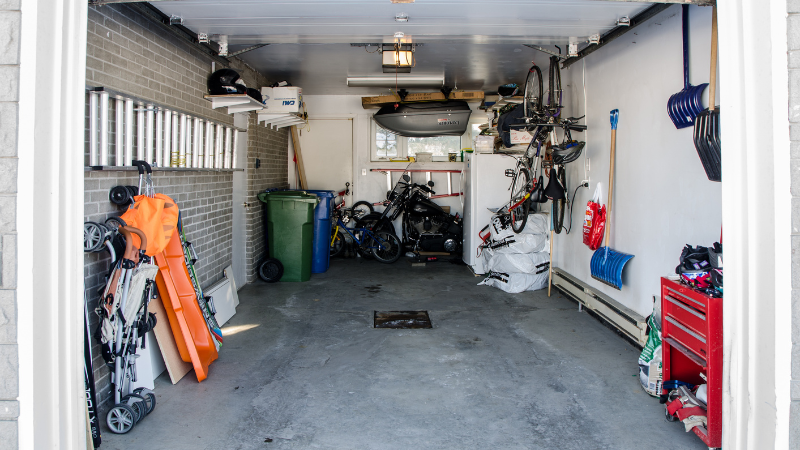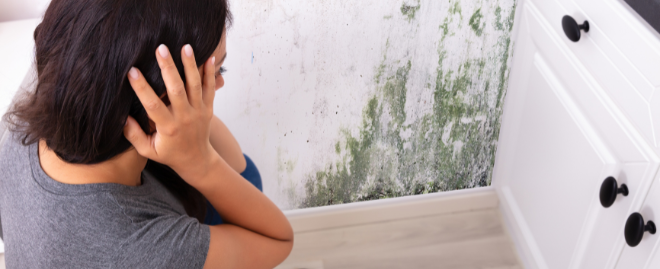How to Prevent Mold on Garage Walls

MoldMold is a type of fungus that grows in damp or humid conditi... More usually appears in dark environments that are moist or damp, however it can grow anywhere indoors and outdoors, including in the garage. There are many ways that moldMold is a type of fungus that grows in damp or humid conditi... More can develop on your garage doors. It may be due to open windows or doors or even the HVAC system, however moldMold is a type of fungus that grows in damp or humid conditi... More can also grow due to dampness caused by a flood or an improperly sealed garage. If the garage is a heavily used space, such as attached garages that are used as the primary entrance to the home, there is an even bigger probability that moldMold is a type of fungus that grows in damp or humid conditi... More will develop. MoldMold is a type of fungus that grows in damp or humid conditi... More sporesSpores are microscopic reproductive units of fungi or mold t... More will appear quickly in the right conditions so be conscious of any garbage or spills in the garage as they can cause moldMold is a type of fungus that grows in damp or humid conditi... More. There are ways that you can get rid of mold from the garage and keep it from forming again.
Why does mold form on garage doors?
Garage doors are an easy target for moldMold is a type of fungus that grows in damp or humid conditi... More to form. They usually have a small amount of insulationInsulation is a material used in buildings to reduce the tra... More, so when it is cold out, there is condensation that forms, especially if you have a heated garage. The moisture from condensation, along with dust and other debris that can be a food source for moldMold is a type of fungus that grows in damp or humid conditi... More, can cause moldMold is a type of fungus that grows in damp or humid conditi... More to form on the doors. As mentioned, poor sealing of the doors lets water in, creating the conditions for moldMold is a type of fungus that grows in damp or humid conditi... More growth. If this is the case with your garage, you should have the seals around the doors replaced by a professional to keep the moisture out.
What types of molds can form in a garage?
All the moisture that forms in a garage will allow for moldMold is a type of fungus that grows in damp or humid conditi... More to grow. Here are some types of molds you may encounter in a garage. Always make sure to have protective equipment on when dealing with moldMold is a type of fungus that grows in damp or humid conditi... More. You should never handle moldMold is a type of fungus that grows in damp or humid conditi... More without the proper equipment.
- Black moldMold is a type of fungus that grows in damp or humid conditi... More (StachybotrysStachybotrys is a type of black mold (often called “black ... More Chartarum):
This type of moldMold is a type of fungus that grows in damp or humid conditi... More is very common and it’s easy to spot due to its color, but also by its shape. It usually grows in circles and it is sticky.
- Green MoldMold is a type of fungus that grows in damp or humid conditi... More (Cladosporium, Aspergillus, and Penicillium):
This type of moldMold is a type of fungus that grows in damp or humid conditi... More is also very common and there are many classifications it may belong to. It is green in color, and it may look like algae.
- White MoldMold is a type of fungus that grows in damp or humid conditi... More:
This type of moldMold is a type of fungus that grows in damp or humid conditi... More is common, it is white in color and may have a hairy appearance. It is not as harmful as other moldMold is a type of fungus that grows in damp or humid conditi... More.
If you’ve encountered a growth in your garage but you are unsure if it’s moldMold is a type of fungus that grows in damp or humid conditi... More, make sure to call the professionals to have it tested and let you know if it is moldMold is a type of fungus that grows in damp or humid conditi... More growth. MoldMold is a type of fungus that grows in damp or humid conditi... More growth should always be treated by professionals to ensure it is fully removed so that it does not harm your health.

How to Prevent Mold in your Garage?
It is important to keep moldMold is a type of fungus that grows in damp or humid conditi... More out of your garage and especially the garage doors. There are some things you can do as a homeowner to prevent moldMold is a type of fungus that grows in damp or humid conditi... More in your garage from forming. Here are a few:
- Inspect your garage regularly:
Always make sure that you are on the lookout for any roof damage, pipe damage, drywall damage, or any other damage that may become a food source for moldMold is a type of fungus that grows in damp or humid conditi... More.
- Organize your garage:
Keep the items you have in the garage on shelves as opposed to the floor. Keeping items on the floor may cause spills which can become a food source for moldMold is a type of fungus that grows in damp or humid conditi... More.
- Make a new garage mold-free:
If you are building your own garage, make sure you use mold-resistant materials.
- Keep plants away from the garage:
Having lots of plants around the outside of the garage can cause cracks where moisture can enter the garage and cause moldMold is a type of fungus that grows in damp or humid conditi... More.
Always make sure that your garage is well ventilated and dry. This will keep moisture away which helps prevent moldMold is a type of fungus that grows in damp or humid conditi... More from forming.
- Have proper drainage:
Your garage should have a drainage system that will keep moisture away from it. This means that any moisture that comes in on your car or seeps into the garage, including rain or snow, should be drained quickly and efficiently. This will keep your garage dry and reduce the chances of getting moldMold is a type of fungus that grows in damp or humid conditi... More.
Even if you take all the precautions we mentioned, you may still face moldMold is a type of fungus that grows in damp or humid conditi... More in your garage. If you encounter moldMold is a type of fungus that grows in damp or humid conditi... More, you can react right away by doing the following:
- Make sure to remove any water that may be on the surface and dry all areas
- Use a dehumidifierA dehumidifier is a device that removes excess moisture from... More to remove all moisture
- Ventilate the area
- If you do have plants on the garage walls, make sure to use mildew-resistant paint on the concrete
- Do not use cardboard boxes for storing, instead use plastic totes
- If you are building your own garage or remodeling it, use materials that are mildewMildew is a type of fungus that grows on damp surfaces, typi... More and moldMold is a type of fungus that grows in damp or humid conditi... More resistant
Professional Mold Remediation
If you’ve done everything in your power to prevent or get rid of moldMold is a type of fungus that grows in damp or humid conditi... More in your garage and it still persists, it is time to call the professionals for complete mold remediation services to fully remove the moldMold is a type of fungus that grows in damp or humid conditi... More growth. These professionals will remove moldMold is a type of fungus that grows in damp or humid conditi... More from anywhere in your home and restore the damage it caused.












